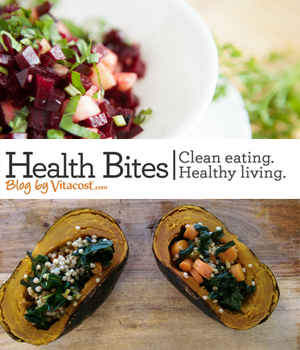Everything You Need To Know About Vitamin D
Vitacost has provided me with another great guest post to share with my readers! Thanks Vitacost ![]() Read on to learn more about Vitamin D, where to get it and how you can ensure you are getting enough.
Read on to learn more about Vitamin D, where to get it and how you can ensure you are getting enough.
1. What does vitamin D do? This multi-tasking vitamin keeps your bones strong and sturdy by promoting absorption of calcium (without it, your body can only absorb 10-15% of the calcium you ingest!), supports normal immune response and lends a hand to help maintain heart health. And if all of that wasn’t enough, vitamin D has also been linked to mood, joint function and skin health.
2. How does my body make vitamin D? They don’t call it the sunshine vitamin for nothing. When skin is exposed to UV-B rays from the sun, a naturally occurring chemical in the body (7-dehydrocholesterol) converts the energy into vitamin D. It’s then transported to the liver where it picks up hydrogen and oxygen molecules, then heads off to the kidney to be converted into the active form your body needs. This process only occurs through direct exposure to strong, mid-day sun – something most of us don’t experience very often.
3. What foods contain vitamin D? You can put vitamin D on your plate by piling it high with fatty fish, cod liver oil, oysters, dairy products, eggs and fortified foods such as cereal and milk. Since many of us don’t eat mass quantities of these foods (sardine omelet, anyone?), it can be difficult to obtain vitamin D through diet alone.
4. How do I know if I need extra vitamin D? You always wear sunscreen, and you don’t eat fish or dairy. So are you “d”-ficient? Studies suggest that upwards of 60% of American adults are, especially those living in Northern climates. But the only way to know whether or not your body has enough is to get your vitamin D levels tested by your doctor or healthcare provider.
5. What type of vitamin D should I take? If your doctor recommends a vitamin D supplement, look for vitamin D3 (also known as cholecalciferol), which is the same form that your body makes when exposed to sunlight. For a wide range of affordable vitamin D3 supplements, including liquids, softgels, capsules, powders, chewables and much more, visit an online health retailer such as Vitacost.com.
6. How do I take vitamin D? Vitamin D is a fat-soluble nutrient. Once you find the vitamin D3 supplement that’s right for you, be sure to take it with a meal that contains healthy fat (such as olive oil, nuts, seeds, avocado, etc.) for maximum absorption and effectiveness.
Vitacost.com has been selling discount vitamins since 1994. Since then we have grown into one of the biggest online marketplaces for healthy living essentials-with vitamins and supplements being just one of our many helpful categories! Get the best price on vitamins, nutritional supplements, health foods and diet products. Vitacost carries raspberry ketones and chia seeds. Our customers mean the world to us, and it’s our goal to provide you with the best nutritional supplements, natural foods and sports nutrition to help with your health and wellness.
By: +Katie Kaleita, writer for Vitacost.com


